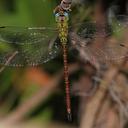Description: Small, rather drab Darner of south Texas.
Males: Eyes blue-green, face olive. Thorax ligth green with faintly indicated brownish wash on front. Abdomen mostly brown, sides of S1-2 greenish, also ligth green dorsal stripe on S2 and fine transverse markings on middle segments becoming obscured toward rear.
Females: Colored similar to male; eyes greenish to brown, perhapsnever with blue. Cerci long, narrow and pointed, broken off in mature individuals. Close look at appendages necessary to deternibe sex, as females with appendages look much like males (Paulson, 2009).
Size: Total length: 59-66mm; hindwing: 34-43 mm.
Similar Species: Should not be confused with anyting else where it occurs. Conspicuosly smaller than Bar-sided Darner, with no blue markings on top or dark brown markings on sides of thorax and never dark stripes along front of wings. Both have pale legs. Closest to Blue-faced Darner in size and even in color pattern, but that species darker everall with dark legs and usually blue face. Mature Blue-faced much mor brightly colored than Pale-green, also has fine green median line down length of abdomen not present in Pale-green.
Habitat: Known from dense woodland adjacent to Rio Grande, where locally common. Breeds in forested swamps in tropics. Some potential breeding habitat in south Texas woodlands.
Natural History: Both sexes hang up during day in woodland, usually dense, and forage at forest edge from ground level to well up in trees at dusck; may be second flight at dawn when warm in depression on dry forest floor that fill with water at beginning of rainy season.
Distribution: USA: Texas (Hidalgo and Cameron County) and Florida (Monroe and Collier County); Mexico to Bolivia and Brazil.
Source:
Paulson, D. 2009. Dragonflies and Damselflies of the West. Princeton University Press. 536 pp.
Edited by Juan Cruzado (03/11/2017)
